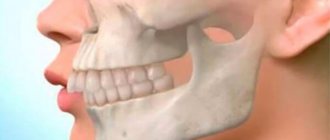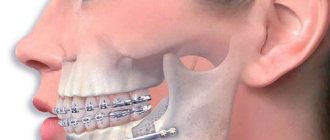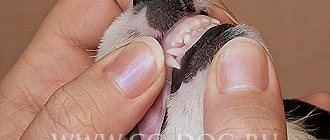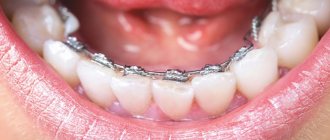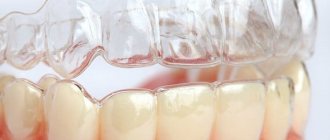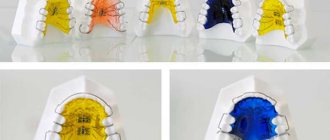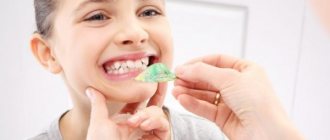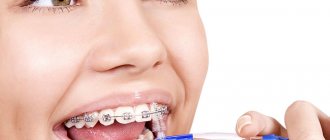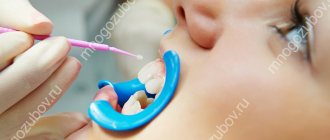Crossbite
It can occur in both children and adults. It is a horizontal intersection of the dentition or jaws.
It is strongly expressed visually, which brings moral discomfort. Occurs when there is a discrepancy in the development of the lateral parts of the jaws. There are both one-sided and two-sided.
Transversal malocclusions (crossover) are divided into lingual, palatal and buccal.
- Lingual bite is characterized by a displacement of the jaw towards the tongue.
- Palatinal - the jaw is shifted towards the palate.
- Buccal - displacement is observed towards the cheek.
This anomaly occurs for a number of reasons. Among the main ones it is worth noting: traumatic factors, lack of teeth in the dentition, pathologies of the temporomandibular joint, disruption of the teething process.
The most common complaints with crossbite include:
- aesthetic defect;
- problems with chewing food;
- slurred speech;
- frequent gum injury.
Malocclusion in children
The formation of a pathological bite in children can begin already in infancy. Most often, malocclusion is diagnosed in children receiving artificial feeding. The fact is that in newborns the lower jaw is somewhat shortened in relation to the upper, and in the first year of life, in the process of natural feeding, the size of the jaws becomes equal. Sucking the mother's breast is accompanied by active work of the facial muscles and movements of the lower jaw, which contributes to its development. In contrast, bottle feeding does not require the baby to actively suck and engage the lower jaw, so it continues to lag behind the upper jaw in size.
However, breastfeeding children for too long (more than 1.5 years) can also lead to the formation of malocclusion. In addition, at this age, the child’s diet must include dense, solid foods that require careful chewing. Otherwise, insufficient load on the chewing apparatus will also contribute to the development of malocclusion in children.
Bad oral habits adversely affect the development of a child’s dental system: frequent and uncontrolled use of a pacifier, lip biting, finger or toy sucking, bruxism, nail and pencil biting habits, etc. In these cases, the formation of a diastema is also possible. The occurrence of malocclusion in children can be caused by the monotonous position of the child’s head during feeding or sleep (throwing the head back or lowering it onto the chest, the habit of sleeping in the same position, placing a hand under the cheek, etc.).
A close relationship is noted between the state of the bite and the child’s breathing pattern. Impaired nasal breathing (with adenoids in children, chronic rhinitis, deviated nasal septum, nasal polyps) and breathing through the mouth leads to incorrect tongue position, non-closure of lips and teeth in the frontal area and the formation of an abnormal bite in children. In turn, malocclusion also contributes to the transition to mouth breathing, a decrease in the volume of the nasal cavities and narrowing of the nasal passages, poor heating and humidification of the air stream, insufficient bacteriostatic and bactericidal function of the mucous membrane and frequent respiratory diseases - sore throats, laryngitis, tracheitis, bronchitis and pneumonia .
An important role in the formation of malocclusion in children is played by the premature loss of baby teeth, violation of the timing of teething due to a lack of minerals in the body (fluorine, calcium), adentia, multiple caries, short frenulum of the tongue, and jaw injuries. In some cases, malocclusion is inherited by children from their parents. It is relatively rare for malocclusions in children to result from birth defects such as cleft palates or underdeveloped jaws.
Sagittal bite
Sagittal malocclusions are often combined with transverse ones. They are characterized by displacement of the jaws in relation to each other. This may be an overdeveloped lower jaw and an underdeveloped upper jaw and vice versa. Such pathologies are divided into mesial and prognathic.
In the first case, a noticeable protrusion of the upper jaw can be observed. The lower one is noticeably underdeveloped, which causes significant deformation of the face in the form of a sloping chin.
In the second case, the lower jaw is noticeably protruded, which causes a significant disproportion.
Such anomalies arise due to a different number of teeth in the jaws, pathology of the development of the alveolar processes, or pathologies of another similar type.
With such defects, the patient experiences difficulty in eating and there is blurred speech. Due to the incorrect position of the jaws, a constantly tense facial expression occurs.
The defect is eliminated in childhood (up to 11 years) with the help of modern technologies, in adults, especially in advanced cases, through surgical intervention.
Preventive measures
Correcting a malocclusion will require a lot of time and patience from the patient. Treatment often takes place over 2-4 years. This is followed by a recovery period, which may take even longer. It is very important to correct the anomaly in childhood, not forgetting about the prevention of pathology.
Parents should take care of the health of their children. They need:
- observe the baby's correct sucking during feeding;
- fight bad habits, that is, sucking foreign objects;
- control the baby’s position when he sleeps;
- monitor the child’s posture;
- monitor the hygiene and condition of milk and molars;
- control his breathing rate;
- treat teeth in a timely manner;
- carry out disease prevention.
It is more difficult to treat dental abnormalities in adults because it requires more money and time. The duration of therapy depends on the condition of the teeth, the degree of incisal overlap and deformation of the rows. With proper and competent treatment, the anomaly will be completely eliminated. To avoid unpleasant consequences in the form of the development of other pathologies, the disease cannot be started.
Children's bite defects
According to statistics, approximately 70% of children have malocclusions. Most of them require treatment using complex techniques. Specialists experience significant difficulties when working with children. This is due to the attitude of young patients towards the event. They do not always follow doctors' recommendations, which is why treatment is ineffective.
About a third of children do not receive the necessary therapy, which subsequently causes a relapse of the disease. Bite pathologies in school-age children are in most cases accompanied by numerous carious lesions of the teeth, as well as various concomitant diseases, such as periodontal disease. Therefore, treatment must be carried out on time.
Important! Orthodontic diseases in children require long-term treatment. On average, it lasts from 10 months to one and a half years. During this period, you must carefully follow the doctor’s recommendations and come for scheduled examinations on time. They are necessary to evaluate treatment results and correct methods.
Malocclusions in children are classified into 5 types:
- cross;
- deep;
- open;
- mesial;
- distal.
Cross occurs due to unilateral or bilateral underdevelopment of the jaws. As a result, the dentition overlaps.
A deep bite appears due to underdevelopment of the lower jaw. As a result, the upper row of teeth significantly overlaps the lower one.
An open bite is characterized by non-occlusion of the dentition over a significant segment. This pathology can appear both in the front and side of the jaw.
Mesial occlusion is characterized by an overly protruded lower jaw, which causes significant overlap of the upper dentition.
With a distal bite, the upper jaw is pushed forward, which causes the effect of a slanted chin.
All these types of malocclusion in preschoolers have certain causes. The main factors influencing the development of the jaws and the formation of the dentition are:
- Genetic factor.
- The presence of chronic diseases accompanied by difficulty in nasal breathing.
- Habit of thumb sucking and lip or tongue biting.
- Late weaning from the pacifier.
- Lack of calcium in the body.
- Injuries and damage to teeth and jaws.
- Numerous carious lesions.
- Extracting baby teeth too early or too late.
Important! Bite pathologies in children should be treated as early as possible. An advanced disease can lead to significant complications, as well as problems with chewing and speech.
Types and classification of malocclusions
The following malocclusions are distinguished:
- upper protrusion. This defect is that the upper incisors are tilted forward. It is caused by the small size of the jaw or the presence of bad habits in the child (prolonged sucking of pacifiers, oblong objects);
- displacement of the midline of one or both rows. Normally, this line should be in the middle and coincide for both rows;
- crowding of teeth. Lack of spaces between teeth, close arrangement (in severe cases - on top of each other, with one tooth overlapping another) of teeth, often accompanied by incomplete eruption of certain groups of teeth due to lack of space;
- trema, diastema. Large gaps between teeth;
- open bite. This is the lack of contact between the teeth of the upper and lower jaws when closing, the formation of a gap. May be in the area of the front teeth or on the sides of the jaws;
- deep bite When it occurs, the upper teeth overlap the lower teeth more than is normally necessary. In severe cases, the lower teeth touch the palate;
- distal bite. In this case, the upper incisors move forward relative to the lower dentition;
- mesial bite. The teeth of the lower jaw protrude forward;
- crossbite. With this anomaly, the teeth shift in different ways: in one area the upper ones protrude forward, in another – the lower ones. The dentition does not overlap each other, so this pathology is considered one of the most severe;
- transposition. In this case, the eruption of several teeth occurs in the same places;
- rotation. This is the rotation of the tooth along its axis.
The causes of malocclusion can be different. Despite the fact that defects most often form in childhood, adults are not immune from pathology. In adulthood, malocclusion can be caused by damage or loss of teeth, eruption of wisdom teeth, disturbances in the tone of the chewing muscles, and diseases of the oral cavity.
Tests to determine malocclusion
When diagnosing bite pathologies, specialists use various research methods. There are already developed tables with which you can identify even minimal deviations and prevent its development at an early stage.
Tests for malocclusion are performed both by direct examination and by dental impressions. In the process, measurements are taken in various planes, and attention is paid not only to the dentition as a whole, but to the presence and location of each tooth, as well as their general condition.
Important! Even if there is no visually noticeable bite pathology, it is imperative to visit a specialist and undergo testing. It will help identify the development of anomalies at the initial stage, when deviations are minimal.
Types of bracket systems
Treatment of deep bite in adults occurs with the use of orthodontic systems. Devices can be made of ceramics, metal, plastic and other materials. They also differ in the way they are installed on the teeth and the duration of use.
You can choose the type of device to correct your bite yourself, but it is better to follow the recommendations of an orthodontist, who will select the best option. In addition, the specialist prescribes the duration of treatment, which on average is 1-2 years. While wearing special structures, it is necessary to regularly visit the doctor, since he needs to monitor the condition of the patient’s teeth.
Adults can be prescribed mouthguards or trainers, but the most effective systems are braces. These devices come in several types:
- Metal. A simple, inexpensive design can produce positive results. Metal appliances sit firmly on the teeth. If necessary, they are reinstalled.
- Plastic. Such structures are almost invisible because they are made to match the color of the teeth. Plastic braces are stained by food. They are less durable than metal variations, so they have to be glued often.
- Ceramic. Expensive devices are considered more durable than structures made of metal and plastic. They are characterized by a high degree of friction, so treatment takes a long time.
- Sapphire. The most expensive systems that are not visible on the teeth.
- Ligable. These braces consist of metal or rubber ligatures to which an arch is attached. With such a clutch, the devices turn out to be rigid. They are also capable of limiting slipping. Since the adhesion weakens over time, the patient will have to visit the doctor once a month.
- Self-regulating. The design has a latch, thanks to which the arc is tightly fixed inside the lock. The device itself does not cause discomfort to the patient.
- Lingual. The device is installed on the teeth from the tongue side, so it is not visible to others. An individual system is selected for each patient.
Correcting deep bites in adults is sometimes only possible through surgery. It is used in cases where orthodontic structures do not help. This method significantly transforms the face of a person, who becomes more attractive.
Surgery to correct deep occlusion is complex and very expensive. Surgical intervention is necessary in case of an open bite in the area of the front teeth, violation of the shape of the chin or facial symmetry, as well as in case of a genetic predisposition to pathology.
How to prevent bite pathologies
To prevent the development of anomalies, you need to follow a number of simple rules:
- During pregnancy, you need to carefully monitor your health and eat foods rich in calcium.
- After the birth of a child, do not transfer him to artificial feeding unless necessary. Bottle feeding affects the formation of the bite.
- After teething, monitor their condition and visit the dentist on time.
- Do therapeutic exercises that provide the necessary load on the facial muscles.
Prevention of malocclusion is necessary for both children and adults. Pathology can manifest at any age if appropriate factors are present. Therefore, regular examinations are necessary. If a specialist identifies a predisposition to the development of a certain disorder, he will recommend appropriate means of preventing malocclusion.
To prevent the disease, more complex measures may be needed than therapeutic exercises and compliance with a number of the rules described above. In some cases, you will need a set of devices for the prevention of malocclusions, which the doctor will select depending on the situation.
You cannot use devices to prevent malocclusions on your own, only on the recommendation of a specialist. Their unsystematic use can significantly worsen the current condition and provoke the development of pathology.
Causes of manifestation
A malocclusion can form for several reasons. This is influenced by heredity, intrauterine development and postpartum factors.
Reasons leading to the manifestation of the defect:
- A baby can inherit pathology from his mother if she has viral or endocrine diseases, metabolic disorders or anemia.
- The reasons are the problems that accompany pregnancy. The unborn child's bite may deteriorate due to improper or slow intrauterine development, infections and toxicosis of the pregnant woman, multiple births and mechanical injuries.
- Deep occlusion is formed in the postpartum period due to prolonged sucking of the baby's finger or pacifier, as well as lip biting.
- Early or late eruption of baby teeth or their replacement with permanent ones, multiple caries, osteomyelitis of the jaw or partial adentia can also cause pathology.
- Other factors in the development of the anomaly are congenital or acquired pathologies of the musculoskeletal system, for example, rickets, scoliosis, systemic skeletal diseases, congenital muscular torticollis.
- The development of vertical anomalies of occlusion can be affected by diseases of the gastrointestinal tract and ENT organs.
- Impaired breathing, swallowing and speech, jaw injuries or problems with the facial skeleton can also form an anomaly.
Sometimes the bite is deformed with baby teeth due to a congenital defect. The disease can be eliminated when the baby's molars erupt. If deep bites appear in milk specimens, children are included in a special risk group, since their condition will need to be monitored.
Expert opinion
Ravcheeva Yulia Anatolyevna
General dentist
This malocclusion can cause damage to the teeth, gums, lining of the mouth, jaw muscles and joints. Therefore, parents need to carefully monitor their child’s hygiene and habits!
What are the anomalies?
Malocclusions in infants are possible in three directions:
- sagittal - pathologies are formed in the anteroposterior direction;
- vertical - arise due to tooth loss, which disrupts contact between the dentition;
- transversal - jaw movement occurs in the temporomandibular joint on different sides.
Types of malocclusion
There are 5 types of malocclusion in children:
- Distal (prognathic) - formed due to the absence of teeth or installed implants. The distal type of the anomaly is characterized by excessive development of the maxillary bone, which is slightly shifted forward.
- Medial (reverse) - characterized by an underdeveloped lower jaw, which leads to overlap of the upper incisors.
- Open - distinguish between front and side. Open anterior bite - the upper and lower incisors do not meet when the molars are closed. Open lateral bite - the molars do not close together when the incisors are closed.
- Deep - the upper teeth completely cover the lower teeth. This type is also called traumatic, as it leads to the abrasion of tooth enamel.
- Cross - formed when the dental arches are disturbed. In this case, the teeth are strongly displaced laterally from the upper or lower jaw.
Bite pathology - lower jaw forward
The type of pathological bite, accompanied by pushing forward of the lower jaw, is called medial. The pathology is reflected in the appearance: the massive chin and lower lip are noticeably pushed forward, the middle part of the face is concave.
The appearance of pathology is often influenced by factors such as:
- birth injury;
- short frenulum of the tongue;
- poor development of the upper jaw;
- heredity;
- long process of changing teeth;
- uncomfortable position while sleeping;
- suffered rickets.
Correcting an abnormal bite will help avoid complications
Medial malocclusion is quite rare and is corrected using orthognathic surgery, as well as myogymnastics. If you do not seek help from an orthodontist in a timely manner, various dental diseases will begin to develop over time and plastic changes will occur.
You should take care of the condition of your child’s teeth from an early age, because preventing a problem is much easier than eliminating its negative consequences. Regular visits to the dentist will help to recognize pathological changes in the bite at the initial stage and correct possible defects as early as possible in order to avoid serious dental problems in the future.
Vertical anomalies of jaw closure
Photo: Vertical malocclusion
- Bite defects in the vertical direction include open and deep bites.
- Such anomalies are characterized by a low or high position of a group of teeth relative to the occlusal surface, as well as dentoalveolar elongation in the event of loss or destruction of antagonist teeth.
- Clinical manifestations of vertical anomalies depend on the cause of the defect, localization in the dentition, and the severity of the disorders.
One of the ways to correct malocclusion in children is to eliminate etiological factors.
Treatment of vertical anomalies in adults is reduced to the use of fixed orthodontic structures using intermaxillary rubber traction, removable trays, Katz guide crowns, and Engle arches.
